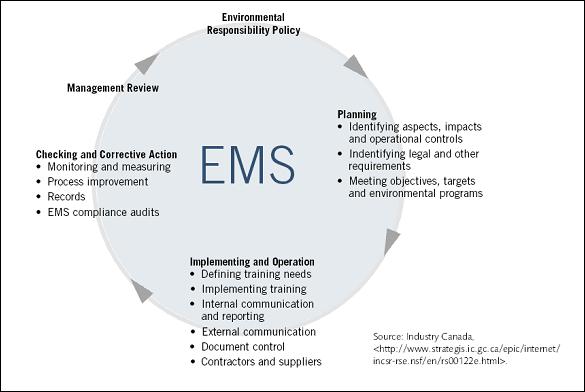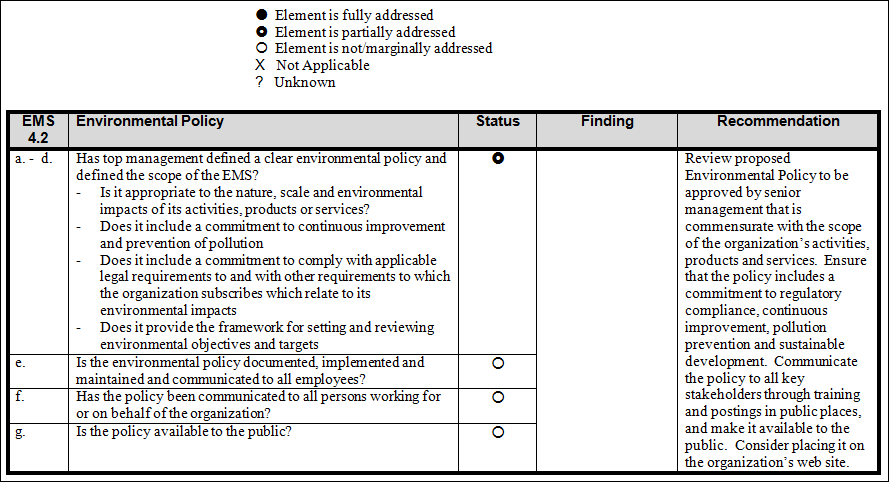 info@alexramsay.ca | 1-905-510-0396
info@alexramsay.ca | 1-905-510-0396
Specialties >> Return to Articles List
ISO 14001 ENVIRONMENTAL MANAGEMENT SYSTEMS
ISO 14001
Increasingly the International Organization for Standardization (ISO)standards with respect to environmental management systems are being accepted and used as a voluntary system by pro-active corporations. The ISO 14001 standard is based on the concept that better environmental performance can be achieved when environmental obligations are systematically identified and managed. This reflects the tenets of Total Quality Management and requires a company to establish an environmental policy, identify its key environmental issues, set objectives, establish procedures to implement the policy and adopt training and documentation procedures. Internal environmental auditing and periodic management review is part of the requirement. The company must be committed to its environmental management system, comply with applicable laws and be committed to pollution prevention and reduction of negative environmental effects. ISO 14001 represents a collaborative effort of experts from around the world to identify an effective environmental management system. This standard is relevant to manufacturers of goods where a buyer subscribes to and requires compliance to ISO 14001 standards to do business. Implementation of an EMS such as ISO 14001 can be implemented by the company with the cooperation of the client.
Environmental Management System to meet ISO Standard
S. A. RAMSAY & ASSOCIATES INC. is available to conduct a Gap Analysis for your organization to help facilitate the development and implementation of an environmental management system (EMS) that will help you achieve ISO 14001:2004 certification. This would include an interview of select employees, site inspections of your facilities and the review of background documentation to identify current gaps in conformance to the International Organization for Standardization (ISO) 14001:2004 standard. A report would then be prepared in draft and discussed with management to assure its practicality before the Gap Analysis is finalized and presented to Management.
Based on the Total Quality Management "Plan-Do-Check-Act" model for addressing performance issues, the ISO 14001: 2004 Standard describes the 18 basic elements of an EMS that are essential for ensuring regulatory compliance and driving environmental improvements. Figure 1 shows these basic components and the key elements of an EMS.
Figure 1 - EMS Elements

It is important to note that the ISO standard focuses on conformance with established policies, plans, and procedures, but it does not specify requirements for environmental performance beyond compliance with the relevant legislation. However, the successful implementation of an EMS could help your organization minimize environmental and social impacts, ensure regulatory compliance, and achieve potentially significant environmental improvements and cost savings. This will make your organization more efficient and thus sustainable over the long term.
The Gap analysis would include observations, identifies gaps in conformance, and suggest actions that will help your organization develop an EMS that will not only satisfy the requirements of the ISO Standard but could also provide both tangible and intangible benefits to the organization. This may include employee loyalty and pride of belonging to a progressive organization, which cares about its employees, the environment and its customers. Recommendations for improvements would be summarized and described in more detail, by ISO element and numbered in accordance with the elements of the ISO Standard, as provided in Table 1 below e.g. 4.2 Environmental Policy.
1. Approve Environmental Policy
An organization's environmental policy is the foundation of its EMS. The environmental policy communicates management's commitment to and endorsement of the EMS to employees, contractors, customers, and stakeholders. As shown in Figure 2, it also provides the framework for all of the other elements and drives performance improvements.
Figure 2 - EMS Structure

As the first step in developing an ISO-certifiable EMS, your senior management should review the current Proposed Environmental Policy is on point and confirm that it fits with the nature, scale, and environmental impact of the organization's operations. The policy should include commitments to regulatory compliance, pollution prevention, and continuous improvement. The development of the environmental policy and subsequent alignment of department strategic plans and budgets will ensure that priorities are consistent throughout the organization and that adequate resources are allocated to meet EMS goals and objectives.
2. Integrate the EMS into Existing Programs, Policies and Procedures
The EMS should not be considered a unique, one-off project or initiative that is the responsibility of the environmental staff and/or contractors. To be truly successful, the ownership and management of the EMS should be shared by all departments and integrated into day-to-day operations and led by an environmental professional supported by appropriate consultants. Rather than creating new policies, programs, and procedures that are independent of existing systems, environmental requirements can generally be integrated into existing programs and activities and develop organically to address real needs identified by your team with the assistance of external experts:
- New Hire Orientation and other required HSE Training
- Management Review
- Purchasing policies
- Document Control and Recordkeeping
- Environmental Monitoring
- Internal Audits and HSE Inspections
- Research and Development
Integrating environmental requirements into existing systems and events will help make the EMS more efficient by minimizing redundancy, ensuring consistency across operational areas and departments, and reduce costs and resources for ongoing production and maintenance.
3. Determine Internal and External Requirements
Compliance with federal, provincial, and local environmental regulations is the primary responsibility of most HSE Departments. Often, there is no formal internal process to systematically track and communicate relevant regulatory changes or to reliably ensure that all requirements are being consistently met. This gap presents a risk that could affect compliance status, impact operations, and/or have unknown or unexpected costs. This should trigger the development of a procedure for identifying and tracking applicable local, provincial, and federal regulatory requirements, and then communicating updates and potential changes to permits, plans, reports, training, and records to affected staff and stakeholders such as subcontractors.
Developing a matrix that shows all applicable legal and other requirements (permits, plans, monitoring, inspections, reports, etc.); frequency of occurrence; and the individuals assigned responsibility for completion of each task will help minimize the risk of non-compliance. It will also have the added benefit of making the EMS more robust and not as reliant on individual staff membersí institutional knowledge. To aid in this task, a template for the Environmental Requirements Matrix would be provided at the culmination of the site visit.
4. Evaluate Aspects and Impacts
Environmental issues are the elements of an organization's activities, products, or services that can have a beneficial or adverse effect on the environment. To help you assess environmental issues, several departments should participate in an Analysis of Impact exercise, on forms to be provided. A formal process to evaluate more accurately and precisely the environmental impacts of your products and services is recommended. A systematic review of your sites' environmental aspects and impacts would be conducted to help identify potentially significant risks and opportunities for improvement. The selected significant environmental issues should then be considered a priority of the EMS and appropriate resources committed to help achieve site goals. This environmental review will help you provide a record, which demonstrates that appropriate criteria were considered in selecting objectives and goals, and that the necessary corrective actions are taken to mitigate impacts.
5. Set Objectives and Targets and Drive Performance Improvements
A successful EMS will enhance an organization's efficiency of operations, reduce resource consumption and waste generation, ensure compliance with regulatory requirements, and improve relations with customers and other stakeholders. These benefits all correspond to actual cost savings that are good for both business and the environment. In order to improve performance in these areas, you should establish clear, measurable objectives and goals to address significant environmental aspects and link these measurements to the framework specified by the policy.
A "Green" environmental policy brochure can then be produced to describe the organization's commitment to environmental protection and sustainable operating practices. Recommendations to define the scope and duration of needed actions; identify and track key performance indicators and metrics; and assess progress annually would be available.
When setting objectives and goals, you must consider legal requirements, stakeholder feedback, and technological, financial, and other operational considerations. Potential key performance indicators could include:
- Number of regulatory inspections and non-compliances
- Volume of waste generated and costs
- Amount of solid waste recycled and savings
- Volume of greenhouse gases emitted and carbon footprint
- Energy consumed (natural gas, electricity, petroleum) and means of switching to renewable energy sources
- Water consumption, costs and conservation
- Any other significant issues identified
Ideally, metrics should be tracked and evaluated on a real time basis, rather than 12 months after the fact, to help manage leading (predictive) versus lagging (reactive) indicators. To encourage individuals and departments to take ownership and to assure the success of the EMS, consider adding a criterion to annual performance reviews to assess contribution(s) to environmental improvements. Success of the EMS depends on the involvement and commitment of employees, at all levels of the organization.
6. Develop Documentation for Important Processes and Procedures
S. A. RAMSAY & ASSOCIATES INC. would recommends Work Instructions (WIs) and Standard Procedures (SPs) for those activities that could have an environmental impact or risk, or where the completion of the task currently relies solely upon the knowledge and experience of an individual.
In developing and/or revising existing WIs and SPs, it would be necessary to collaborate with other departments to map out and document the most important procedures and activities that should be controlled. Ideally, environmental requirements could be incorporated into existing WIs and SPs instead of creating new ones that might be redundant or conflict with established practice. By clarifying requirements, by defining roles and responsibilities, and by developing written guidelines, resource efficiency would improve and risk of violations reduced. Documentation of critical procedures will help ensure consistency and make the environmental program more robust.
Some organizations spend an inordinate amount of time writing procedures to document and control every activity potentially related to the EMS. It is important to bear in mind that the ISO 14001 certification audit focuses primarily on conformance to documented plans, policies, and procedures and not necessarily on the performance of the organization. Hence the maintenance and verification of a multitude of irrelevant procedures becomes a burden and provides no real benefit to the organization or the environment. It is the key environmental issues, which should be the focus so that the objectives and goals of the EMS are clearly met.
Table 1 ENVIRONMENTAL POLICY REVIEW MATRIX EXAMPLE
